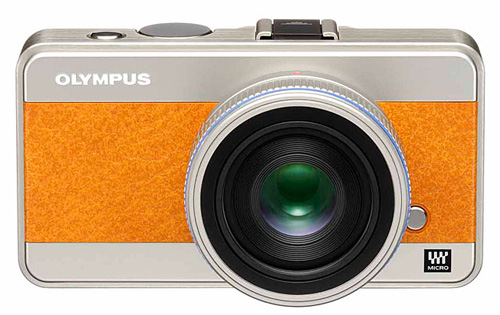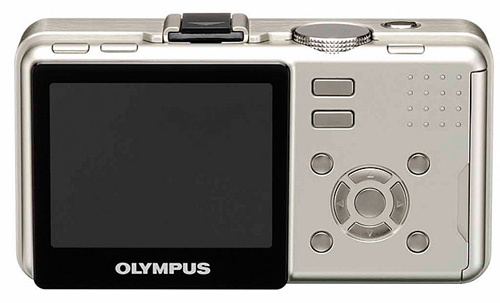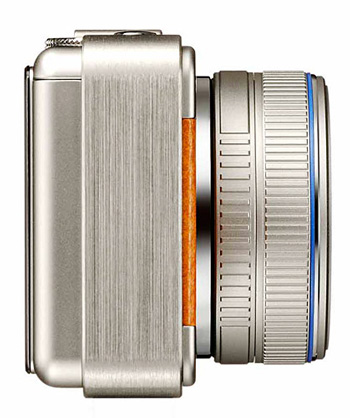Photokina 2008: Full-Frame and Megapixels Rule
by Wesley Fink on September 26, 2008 2:00 AM EST- Posted in
- Digital Camera
Olympus
Olympus created a great deal of interest showing prototypes, but they didn't even have real model numbers to go with the new midrange Olympus DSLR or the prototype of the new interchangeable lens compact based on Micro Four Thirds.
Olympus fans will be pleased to know that Olympus is planning to introduce a new midrange model in the first quarter of next year. The new unnamed model will fall between the current E-520 and the flagship E-3. Finally, Olympus will bring the superb 11 cross-point sensor used in the zippy E-3 to a consumer model with the new camera. The unanswered question is whether the new camera will stick with a 10MP sensor, which is now the lowest resolution among DSLR APS-C cameras, or whether they will move to the new Panasonic Four Thirds 12.1MP sensor used in their new G1.
Olympus was also showing prototypes of their first interchangeable lens compact camera, or point and shoot, based on the Panasonic Olympus Micro Four Thirds standard. You can out more about the new Micro Four Thirds standard in our analysis of the Panasonic G1 launch.



The new Four Thirds Olympus point-and-shoot finally accomplishes what many have been clamoring for in the P&S market - namely a large sensor in a point-and-shoot size body. The prototype has interchangeable Micro Four Thirds lenses and can fit today's Four Thirds lenses by using an adapter. You will also likely see fixed lens Micro Four Thirds cameras at a lower price sometime in the future.
The two new Olympus cameras are intriguing, but they are likely at least six months away. Olympus should have final models ready for PMA in February/March of 2009. Unfortunately, the Olympus press release really did not provide answers to the most pressing questions:
Olympus Developing New E-System Four Thirds System-Compliant Digital SLR Camera
COLOGNE, GERMANY, September 22, 2008 - Olympus today announces that it is developing a new interchangeable-lens digital SLR (single lens reflex) within the Olympus E-System lineup. This new Four Thirds-compliant camera reinforces the company's commitment to the standard.
Positioned as a midrange model, this new digital SLR camera is intended for anyone who wants to express their creativity through photography, whether they are just starting out or are a professional with years of experience behind them. Introduction of the new camera is expected in the first quarter of 2009.
A prototype of the camera will be displayed at Photokina 2008, the world's largest trade fair for the photographic and imaging industries held September 23-28 at the Cologne Trade Fair in Cologne, Germany.
At the last Photokina (September 2006), Olympus declared that the second chapter in the story of the Olympus E-System would begin in 2007. One of the highlights of this chapter was the incorporation of "Full-Time Live View" function as a standard function for the first time in the industry, adding to the excitement already generated by other distinctive features of the E-System such as the "100 percent Digital-Dedicated Design" and "Dust Reduction System." Currently, the E-System lineup includes popular models such as the E-420 and E-520, as well as the flagship E-3. All of these cameras provide digital SLR users with the high-quality images, superior reliability and exceptional portability they need.
The prototype model displayed at Photokina is being developed as an advanced amateur model that will be positioned between the E-520 and E-3. In terms of quality and performance, however, there is nothing midrange about this model. It will inherit all the outstanding features of the E-3 such as the high-speed autofocus system using an 11-point full twin-cross sensor and the built-in image stabilization mechanism with a correction effect of up to 5 EV steps. Other highlights will include a new and updated feature to replace the current splash and dustproof function of the E-3.
With the introduction of this new camera, Olympus will expand its line of Four Thirds System-compliant digital SLR cameras, providing a wider range of choices to a wider range of users from serious amateurs to professionals.
Olympus Micro Four Thirds System-Compliant Digital Camera Under Development

Cologne, Germany, September 22, 2008 - Olympus today announces that it has begun development of an interchangeable lens type digital camera based on the "Micro Four Thirds System".
Development of the camera will bring dramatic reductions in size and weight to the Olympus E-System, and will comply with the new Micro Four Thirds System standard jointly announced with Matsushita Industrial Co., Ltd. (Panasonic) on August 5. A concept mock-up of the camera will be exhibited September 23-28 at "Photokina 2008," the world's largest trade fair for the photographic and imaging industries held September 23-28 at the Cologne Trade Fair in Cologne, Germany.
The global market for interchangeable lens type digital cameras is growing steadily, but still only accounts for approximately 7 percent of the total digital camera market. Considering the much larger share held by interchangeable lens type digital cameras when film was the dominant imaging medium, it seems that there is still ample room for sales growth in this category. Market surveys, however, indicate that more than a few customers choose compact models because they find digital SLR cameras to be "big, heavy, and difficult to operate."
The Micro Four Thirds System standard was established to meet this need by enabling the development of radically more compact and lightweight interchangeable lens type digital camera systems. The camera currently under development will be the first Olympus camera to comply with the Micro Four Thirds System standard, and interchangeable lenses that comply with the standard are also moving ahead. In addition, users will be able to mount existing Four Thirds System wide-angle, telephoto, and macro lenses on Micro Four Thirds System bodies via an adapter. Product name, launch date and retail price of an interchangeable lens type digital camera based on the "Micro Four Thirds System" are not determined.
Olympus Imaging is also committed to the Four Thirds System, and will continue to expand its lineup of digital SLR cameras to satisfy a broad spectrum of customer needs. This includes the professional photographer, aspiring artist, hobbyist, and everyday consumer.
Outline of the Micro Four Thirds standard The Micro Four Thirds standard was designed and developed to maximize the performance potential of digital imaging technology, and to extend the benefits of the Four Thirds System standard for digital camera systems.
When compared to the Four Thirds System standard, the primary distinguishing features of the Micro Four Thirds standard are:
- Approximately 50 percent shorter flangeback distance (mount-to-sensor distance)
- Lens mount outer diameter approximately 6mm smaller
- Electrical contacts in mount increased from 9 to 11
The Micro Four Thirds System enables users to capture the same high-quality images of the Four Thirds System's image sensor in a much more compact body. It also takes advantage of significantly more compact lenses, particularly in the wide-angle and high-power zoom range. The Four Thirds System offers the benefits of compact, lightweight performance, and the new Micro Four Thirds System takes this even further to enable development of ultra-compact interchangeable lens type digital camera systems unlike anything seen before. The new Micro Four Thirds System also incorporates a greater number of lens-mount electrical contacts for the support of new features and expanded system functionality in the future.










16 Comments
View All Comments
haplo602 - Friday, September 26, 2008 - link
sorry guys but WTF are you talking about? how is the AF type relevant to lens motor operation ?I mean the adapter should be translating the signals to the lens properly (unless 4/3 lenses are screw blade driven).
also you could then not AF in LiveView on regular 4/3 systems as they use contrast detect as one of the AF modes ...
please explain ... I am a bit puzzled here ...
Wesley Fink - Friday, September 26, 2008 - link
Obviously it should be 4/3 and not 4/5 in my reply. We DO need an EDIT function.Wesley Fink - Friday, September 26, 2008 - link
Olympus made it clear in specifications (and our testing of the E-520 and Panasonic Lumix L10) that only these four lenses are compatible with contrast detect. You can easily check the E-520 focusing specifications for yourself at http://www.olympusamerica.com/cpg_section/product....">http://www.olympusamerica.com/cpg_section/product.....Since the contrast-detect AF compatibility on these lenses just required a firmware update perhaps more 4/5 lenses will be contrast AF compatible in the future. That is unknown right now.
haplo602 - Friday, September 26, 2008 - link
ah thanks for the link.It seems a bit stupid however :) I mean what does the lens do while focusing ? It just receives signals from the camera which way to move the lens groups. It does nothing in the focus evaluation.
haplo602 - Friday, September 26, 2008 - link
there should be an EDIT function ...EDIT of the above post: Please make a section specific to G1, it is NOT an APS-C DSLR :-)
Wesley Fink - Friday, September 26, 2008 - link
It is not a DSLR but it does use a sensor that fits the broad APS-C category, where 4/3 cameras currently compete. We were very clear to call it an interchangeable lens camera without a mirror box.We have changed the description to APS-C cameras for a more precise description.